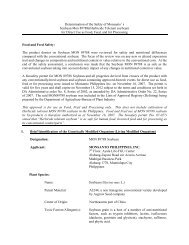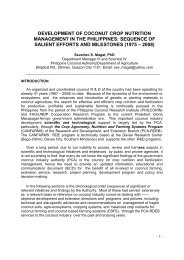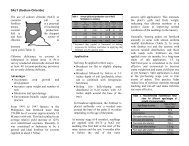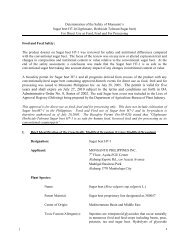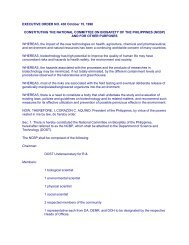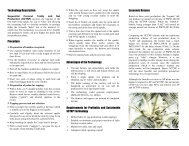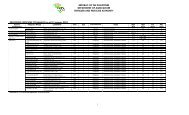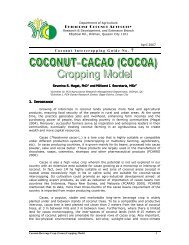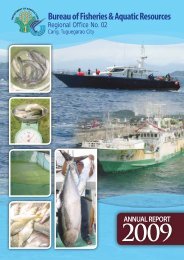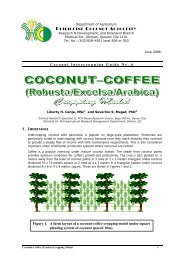out the juice removes much <strong>of</strong> the toxic compounds. Heat used to dry theresulting flour removes the remaining compounds. The resulting flour, calledfar<strong>of</strong>a is very bland, rather like corn meal and flour. The flour can be mixedwith water and the dough cooked on a large griddle to make a large cassavaflat-breads).4.2.1.2 Sweet potato1) Land preparation – To have good root yield <strong>of</strong> the crop, plow and harrow thesoil twice until soil is loose and friable. Form ridges or furrows <strong>of</strong> about 30-40cm high by using carabao-drawn mold-board plow or tractor-drawn moldboard plow or tractor-drawn disc plow with a distance <strong>of</strong> about 75-100 cmsbetween ridges (http://www.da.gov.ph.farming tips [from BPI Sweet PotatoCommodity Pr<strong>of</strong>ile –DA-Eastern Visayas Integrated Agric .Research Center]) ).2) Planting materials and variety – Use sprouts from roots <strong>of</strong> previous crop orvine tip cuttings from healthy plants 25 cm long. However, for economicreasons, tip or terminal vine cuttings immediately or you can store them inshaded place but they should be planted within 2 days from the time the theyare cut).The selection <strong>of</strong> the proper variety to grow is dependent on the purpose forwhich it is grown. The following 14 varieties are recommended by the Phil.Seed Board: UPL SP1, UPL SP 3, UPL SP5, BPI SP 1, BPI SP 2, PSB SB -13,14,15,16,17, UPL SP, VSP -5,6,7 (http://www.da.gov.ph.farming tips[from BPI Sweet Potato Commodity Pr<strong>of</strong>ile –DA-Eastern Visayas IntegratedAgric .Research Center]) ).3) Planting – plant vine cuttings diagonally on top <strong>of</strong> ridges during the rainyseason to prevent the crop from being soaked under water, or in the furrowsduring dry season so that moisture reserve in the soil can be utilized by thecrop. Expose 2-3 leaves at the tip at a distance <strong>of</strong> 25 cms between hills. Onecutting per hill is equivalent to 33,000 hills per ha).4) Fertilization –In the absence <strong>of</strong> soil analysis <strong>of</strong> the area, follow the generalfertilizer recommendation for: poor soil, use 4-6 bags complete (14-14-14)fertilizer /ha, moderate fertile soil – use 4 bags complete fertilizer/ha, forfertile soil, fertilization is not advisable. Apply fertilizer at planting time at 8-10 cms from the base <strong>of</strong> the plant or broadcast in the furrows and coversubsequently with soil. The use <strong>of</strong> compost or organic fertilizer at 3 tons/ha ishighly recommended).5) Cultivation and weeding – If weeds are abundant, shallow cultivation is done10-12 days after planting. Hilling-up cultivation is done at 25-30 days afterplanting. This is to provide enough soil to cover the developing roots andthus, minimize the entry <strong>of</strong> weevils that may attack the growing roots).6) Pest and disease management – Foliar spraying <strong>of</strong> fevinthrothion at 0.5% one(1) month after planting and twice at 50 days and 70 days after planting(DAP).7) Harvesting – Most <strong>of</strong> the recommended varieties are ready for harvest 110-130 DAP. Harvesting can be determined by root sampling and if desired sizehas been attained, harvesting can be done anytime. Before harvesting, cutand roll the vines like a mat, fork, hoe or pass a plow below the ridges, then<strong>Coconut</strong>-Root Crops Cropping Model 10
hand pick the roots. Handle the roots carefully to minimize injury. Sort outdamage or bruise roots from undamaged ones).8) Post harvesting operation – If possible, use wooden crates for containersinstead <strong>of</strong> gunny sacks to avoid skin damage during handling and transport.Harvest roots, if properly cured can be stored even for 3 months by keepingthem under room temperature <strong>of</strong> 115 o F or 32 o C with a relative humidity <strong>of</strong> 92-95).9) Post harvesting diseases – S<strong>of</strong>t rot or ring rot and storage rot are two commondiseases after harvesting. Control measures include storage <strong>of</strong> roots in clean,dry and well-ventilated storage area; care must be taken not to bruise orinjure roots during harvest and transport).4.2.1.3 Gabi1) Planting Materials – are called setts. A sett is prepared from a plant ordaughter plant, i.e, either sucker or rhizome. The setts are prepared byhaving 1-2 cm tip section <strong>of</strong> the parent corm and first 15-25 cm <strong>of</strong> the petiole.The suckers are prepared from pre-sprouted cormels or cut from main corm.Best results are obtained with a sett size <strong>of</strong> 100-120 g. Smaller-sized settscan be used but maturity is delayed. Planting materials should be uniform insize but if different sizes <strong>of</strong> setts are used plant together those that are moreor less <strong>of</strong> the same size (http://vicarp.lsu-visca.edu.ph/technologies.htm).2) Land Preparation - Alternate plowings and harrowing until the soil is thoroughlyprepared for planting and weed-free. Irrigation For Lowland culture –irrigation is maintained at least 3-5 cm water depth during the first threemonths <strong>of</strong> the crop to produce good quality corms. Drain the field once in awhile.3) Varieties <strong>of</strong> Gabi (with average yield per cropping):oooooPSB-VG#1 – (7.2 tons/ha)PSB-VG#2 – (6.7 tons/ha)SB-VG#3 – (7.2 tons/ha)PSB-VG#4 – (6.5 tons/ha)NSIC-G-8 – (7.0 tons/ha)o NSIC-G-6 - (7.0 tons/ha4) Planting Methods4.1 Lowland or flooded culture. The area is flooded first for three days. Plowingand harrowing is done after flooding. Submerge the field in water for 2 daysbefore planting. The gabi setts are planted in the mud with a spacing <strong>of</strong> 75 cmbetween rows and 50 cm between hills. http://www.nomiarc.netfirms.com/pot/gabi.htm).4.2 Upland or dry cultivativation (culture). More suitable in coconut-based areas.Furrows are prepared at a distance <strong>of</strong> 75 cm apart and 30 cm deep. The settsare planted at a distance <strong>of</strong> 50 cm between hills).<strong>Coconut</strong>-Root Crops Cropping Model 11



